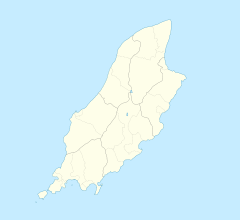|
Peel Lifeboat Station
Peel Lifeboat Station is located in the shadow of Peel Castle on St Patrick's Isle, in the town of Peel, in the Isle of Man, a British Crown Dependency. A lifeboat was first stationed here by the Royal National Institute for the Preservation of Life from Shipwreck (RNIPLS) in 1828.[1] Re-established by the Royal National Lifeboat Institution (RNLI) in 1884, the station currently operates an Shannon-class All-weather lifeboat, 13-35 Frank and Brenda Winter (ON 1342), on station since 2021.[2] HistoryOn the 28 May 1828, Sir William Hillary, President of the Isle of Man District Association of the Royal National Institute for the Preservation of Life from Shipwreck, wrote to the associations headquarters in London, requesting that a lifeboat be placed at both Peel and Ramsey, which was duly agreed. A new boat was provided for Peel, a 26-foot 6-oared Palmer-class lifeboat, built by Taylor of Blackwall, which cost £55, and arrived in Peel on 12 December 1828. Records show only one service, in 1831, to the sloop Jane to rescue the 4 crew, and by 1836, for reasons unknown, the boat was recorded as wrecked.[1] A replacement boat was commissioned with local boatbuilder William Corlett, again a 26-foot "Palmer" inspired type boat. No services were ever recorded, and by 1843, this boat too is recorded as being unserviceable. Following the death of Sir William Hillary in 1848, and with little funding available, there seemed to be no interest in maintaining a lifeboat in Peel, despite the large number of fishing boats operating there. However, in 1883, the Lt. Governor of the Isle of Man wrote to the (now) RNLI, to request that a station be re-established at both Peel and Ramsey, which was agreed. A new boat house was built next to the castle in 1884 by Redcliffe and Anderson, at a cost of £485-9s-10d, and in 1885, a new 37-foot 12-oared boat arrived, built by Woolfe of Shadwell, and costing £397; the John Monk (ON 83), funded by the legacy of Capt. John Monk RN, of Neston, Wirral. John Monk was a retired naval officer who first saw action in the Napoleonic wars, and bequeathed £500 to the RNLI "for the purpose of building a life boat, which shall be named John Monk"[1] After years of launching Peel lifeboats by hand, Peel received their first launch and recovery tractor, a CASE LA (T41) in 1963.[2] Following a coastal service review, the All-weather lifeboat was withdrawn in 1972, replaced with an A-class (McLachlan) class lifeboat. Then followed a further McLachlan boat, and then two B-class (Atlantic 21) lifeboats. In 1990, another coastal review determined that an All-weather boat would once again be placed at Peel, whilst Port Erin would receive an Atlantic 21 Inshore boat to replace their Rother-class All-weather lifeboat.[1] In 1992, Peel's new Mersey-class lifeboat arrived, costing £662,663, and was named 12-22 Ruby Clery (ON 1181), following a generous bequest from the late Miss R. A. Clery of St. John's Wood, London, a great-great-granddaughter of Sir William Hillary. The naming ceremony took place on 12 September 1992, and was carried out by Mrs Karin Bache Nordli, the daughter of the baby rescued off the St George in 1889 (see Notable rescues). The 1884 boathouse had to be demolished to make way for a new building for the Mersey lifeboat and tractor, but much of the original red sandstone was retained and re-used in the construction of the new building.[1] Ruby Clery served Peel for the next 27 years, before she was transferred to Ramsey, and then onto Douglas, where in 2024 she is still in service.[2] Peel received a new Shannon-class lifeboat in 2020, although it was 2021 before she was formally accepted on service, delays in training being caused with the Covid pandemic. The boathouse once again required modifications, being extended on the North side, with larger access doors fitted, new workshop facilities, and a crew room mezzanine above the boat hall, with lookout windows.[3] Notable rescuesOn the 7 October 1889, a large fully-rigged ship was seen in trouble off Peel, badly damaged, with broken masts. The John Monk was launched into the full fury of the storm. It took 16 men rowing a full 2 hours to reach the St. George, a Norwegian ship bound for Montevideo. Unable to get close, a breeches-buoy system was set up, and one by one, 21 crew, the Captain's wife, and baby, were rescued. The lifeboat hadn't reached Peel Harbour on the return trip, before the St George was driven ashore and wrecked. The survivors were landed on the quay to the cheers of a large assembled crowd. For this service, Coxswain Charles Cain and each of the 15 crew received the Silver Medal from the Norwegian Government, and a Manx bible.[4] The figurehead off the boat, "George", was recovered and has been proudly on display at Peel Lifeboat Station ever since. Station honoursThe following are awards made at Peel[1][5]
Peel lifeboatsAll-weather lifeboats
Inshore lifeboats
Launch and recovery tractors
See alsoNotes
References
External links |
|||||||||||||||||||||||||||||||||||||||||||||||||||||||||||||||||||||||||||||||||||||||||||||||||||||||||||||||||||||||||||||||||||||||||||||||||||||||||||||||||||||||||||||||||||||
Portal di Ensiklopedia Dunia


